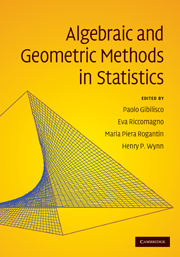Book contents
- Frontmatter
- Contents
- List of contributors
- Preface
- Frequently used notations and symbols
- 1 Algebraic and geometric methods in statistics
- Part I Contingency tables
- Part II Designed experiments
- 9 Generalised design: interpolation and statistical modelling over varieties
- 10 Design of experiments and biochemical network inference
- 11 Replicated measurements and algebraic statistics
- 12 Indicator function and sudoku designs
- 13 Markov basis for design of experiments with three-level factors
- Part III Information geometry
- Part IV Information geometry and algebraic statistics
- Part V On-line supplements
12 - Indicator function and sudoku designs
from Part II - Designed experiments
Published online by Cambridge University Press: 27 May 2010
- Frontmatter
- Contents
- List of contributors
- Preface
- Frequently used notations and symbols
- 1 Algebraic and geometric methods in statistics
- Part I Contingency tables
- Part II Designed experiments
- 9 Generalised design: interpolation and statistical modelling over varieties
- 10 Design of experiments and biochemical network inference
- 11 Replicated measurements and algebraic statistics
- 12 Indicator function and sudoku designs
- 13 Markov basis for design of experiments with three-level factors
- Part III Information geometry
- Part IV Information geometry and algebraic statistics
- Part V On-line supplements
Summary
Abstract
In this chapter algebraic statistics methods are used for design of experiments generation. In particular the class of Gerechte designs, that includes the game of sudoku, has been studied.
The first part provides a review of the algebraic theory of indicator functions of fractional factorial designs. Then, a system of polynomial equations whose solutions are the coefficients of the indicator functions of all the sudoku fractions is given for the general p2×p2 case (p integer). The subclass of symmetric sudoku is also studied. The 4×4 case has been solved using CoCoA. In the second part the concept of move between sudoku has been investigated. The polynomial form of some types of moves between sudoku grids has been constructed.
Finally, the key points of a future research on the link between sudoku, contingency tables and Markov basis are summarised.
Introduction
Sudoku is currently a very popular game. Every day many newspapers all over the world propose such puzzles to their readers. From wikipedia we read:
Sudoku is a logic-based number placement puzzle. The objective is to fill a 9 × 9 grid so that each column, each row, and each of the nine 3×3 boxes (also called blocks or regions) contains the digits from 1 to 9, only one time each (that is, exclusively). The puzzle setter provides a partially completed grid. (http://en.wikipedia.org/wiki/Sudoku)
This description refers to the standard game but also 4 × 4, 6 × 6, 12 × 12 and 16 × 16 grids are played.
- Type
- Chapter
- Information
- Algebraic and Geometric Methods in Statistics , pp. 203 - 224Publisher: Cambridge University PressPrint publication year: 2009
- 2
- Cited by



